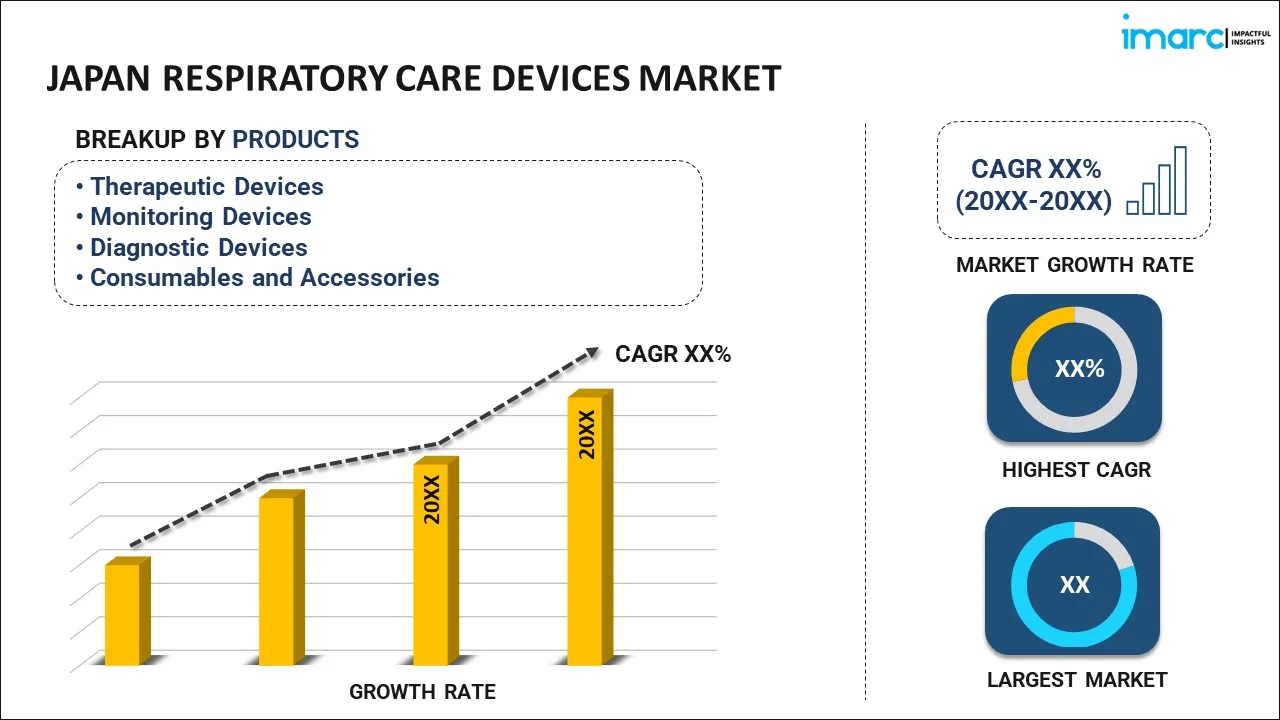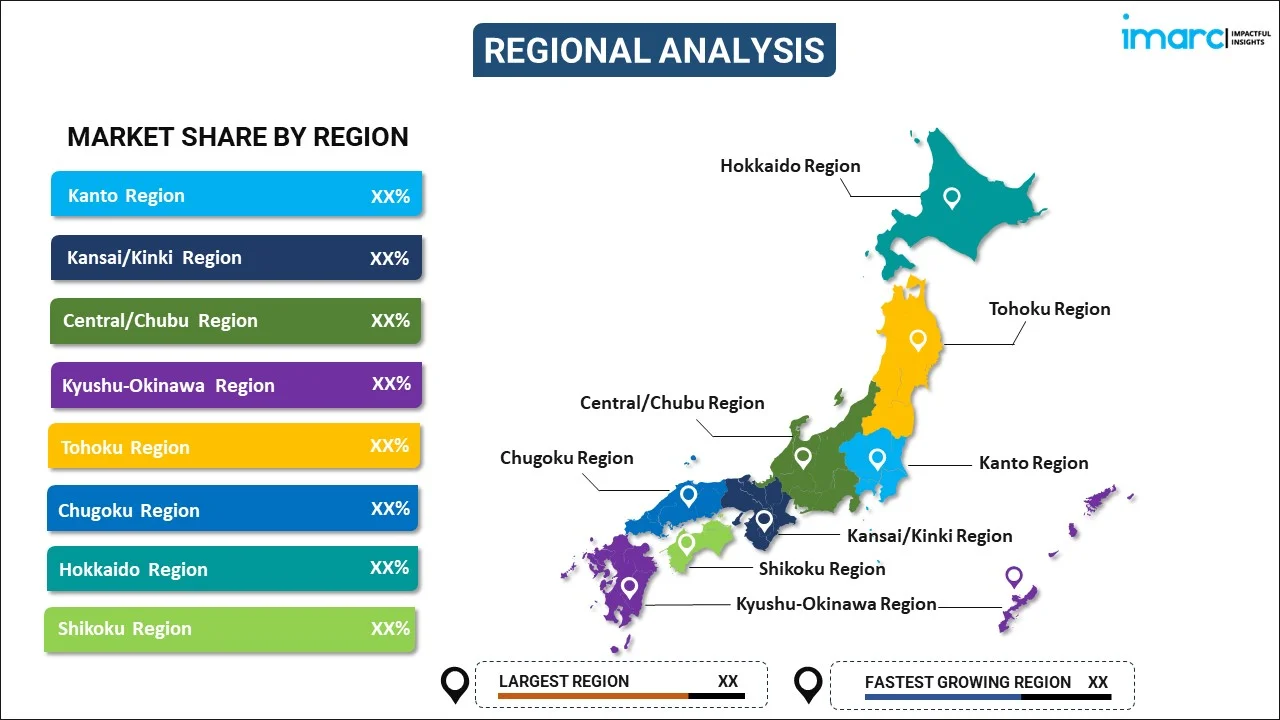
Japan Respiratory Care Devices Market Report by Product (Therapeutic Devices, Monitoring Devices, Diagnostic Devices, Consumables and Accessories), Indication (Chronic Obstructive Pulmonary Disease (COPD), Asthma, Sleep Apnea, Infectious Disease, and Others), End User (Hospitals, Home Care Settings, Ambulatory Care Centers, and Others), and Region 2025-2033
Market Overview:
Japan respiratory care devices market size is projected to exhibit a growth rate (CAGR) of 8.3% during 2025-2033. The increasing healthcare expenditure capacities and the development of miniature devices are primarily driving the market growth.
|
Report Attribute
|
Key Statistics
|
|---|---|
|
Base Year
|
2024 |
|
Forecast Years
|
2025-2033
|
|
Historical Years
|
2019-2024
|
| Market Growth Rate (2025-2033) | 8.3% |
Respiratory care devices are medical apparatus utilized in the management, diagnosis, treatment, and evaluation of patients with pulmonary conditions. Nebulizers, inhalers, positive airway pressure (PAP) devices, spirometers, humidifiers, and others constitute the typical respiratory care device category. These devices predominantly serve diagnostic, therapeutic, and monitoring roles, contributing to the maintenance of unobstructed breathing by delivering an appropriate oxygen supply to the lungs and preventing any hindrances in the respiratory process.
Japan Respiratory Care Devices Market Trends:
The respiratory care devices market in Japan is experiencing significant growth due to several key factors. Firstly, the increasing prevalence of respiratory diseases in the country, including chronic obstructive pulmonary disease (COPD), asthma, and respiratory infections, has led to a higher demand for advanced respiratory care devices. These devices play a crucial role in the diagnosis, treatment, and management of such conditions, thereby driving market expansion. Secondly, Japan's aging population is contributing to the rising demand for respiratory care devices, as elderly individuals are more susceptible to respiratory ailments. The need for continuous monitoring and treatment options to enhance the quality of life for the elderly population is propelling market growth. Furthermore, the adoption of innovative technologies in respiratory care devices is a significant driver. Japan is known for its technological advancements, and the integration of features like wireless connectivity and data monitoring in these devices is improving patient care and facilitating remote monitoring by healthcare providers. Additionally, the COVID-19 pandemic has underscored the importance of respiratory care, leading to increased investments in healthcare infrastructure and a heightened awareness of the need for respiratory care devices. This has further boosted the market in Japan. In summary, the Japan respiratory care devices market is expanding due to factors such as the increasing prevalence of respiratory diseases, an aging population, technological innovations, and the impact of the COVID-19 pandemic, all of which are expected to bolster the demand for advanced respiratory care solutions in the country over the forecasted period.
Japan Respiratory Care Devices Market Segmentation:
IMARC Group provides an analysis of the key trends in each segment of the market, along with forecasts at the country level for 2025-2033. Our report has categorized the market based on product, indication, and end user.
Product Insights:

- Therapeutic Devices
- Positive Airway Pressure (PAP) Devices
- Ventilators
- Nebulizers
- Humidifiers
- Inhalers
- Others
- Monitoring Devices
- Pulse Oximeters
- Gas Analyzers
- Others
- Diagnostic Devices
- Spirometers
- Polysomnography Devices
- Peak Flow Meters
- Others
- Consumables and Accessories
- Masks
- Disposable Resuscitators
- Breathing Circuits
- Tracheostomy Tubes
- Nasal Cannulas
- Others
The report has provided a detailed breakup and analysis of the market based on the product. This includes therapeutic devices (positive airway pressure (PAP) devices, ventilators, nebulizers, humidifiers, inhalers, and others), monitoring devices (pulse oximeters, gas analyzers, and others), diagnostic devices (spirometers, polysomnography devices, peak flow meters, and others), and consumables and accessories (masks, disposable resuscitators, breathing circuits, tracheostomy tubes, nasal cannulas, and others).
Indication Insights:
- Chronic Obstructive Pulmonary Disease (COPD)
- Asthma
- Sleep Apnea
- Infectious Disease
- Others
A detailed breakup and analysis of the market based on the indication have also been provided in the report. This includes chronic obstructive pulmonary disease (COPD), asthma, sleep apnea, infectious disease, and others.
End User Insights:
- Hospitals
- Home Care Settings
- Ambulatory Care Centers
- Others
The report has provided a detailed breakup and analysis of the market based on the end user. This includes hospitals, home care settings, and ambulatory care centers, and others.
Regional Insights:

- Kanto Region
- Kansai/Kinki Region
- Central/ Chubu Region
- Kyushu-Okinawa Region
- Tohoku Region
- Chugoku Region
- Hokkaido Region
- Shikoku Region
The report has also provided a comprehensive analysis of all the major regional markets, which include Kanto Region, Kansai/Kinki Region, Central/ Chubu Region, Kyushu-Okinawa Region, Tohoku Region, Chugoku Region, Hokkaido Region, and Shikoku Region.
Competitive Landscape:
The market research report has also provided a comprehensive analysis of the competitive landscape in the market. Competitive analysis such as market structure, key player positioning, top winning strategies, competitive dashboard, and company evaluation quadrant has been covered in the report. Also, detailed profiles of all major companies have been provided.
Japan Respiratory Care Devices Market Report Coverage:
| Report Features | Details |
|---|---|
| Base Year of the Analysis | 2024 |
| Historical Period | 2019-2024 |
| Forecast Period | 2025-2033 |
| Units | Million USD |
| Scope of the Report | Exploration of Historical Trends and Market Outlook, Industry Catalysts and Challenges, Segment-Wise Historical and Future Market Assessment:
|
| Products Covered |
|
| Indications Covered | Chronic Obstructive Pulmonary Disease (COPD), Asthma, Sleep Apnea, Infectious Disease, Others |
| End Users Covered | Hospitals, Home Care Settings, Ambulatory Care Centers, Others |
| Regions Covered | Kanto Region, Kansai/Kinki Region, Central/ Chubu Region, Kyushu-Okinawa Region, Tohoku Region, Chugoku Region, Hokkaido Region, Shikoku Region |
| Customization Scope | 10% Free Customization |
| Post-Sale Analyst Support | 10-12 Weeks |
| Delivery Format | PDF and Excel through Email (We can also provide the editable version of the report in PPT/Word format on special request) |
Key Questions Answered in This Report:
- How has the Japan respiratory care devices market performed so far and how will it perform in the coming years?
- What has been the impact of COVID-19 on the Japan respiratory care devices market?
- What is the breakup of the Japan respiratory care devices market on the basis of product?
- What is the breakup of the Japan respiratory care devices market on the basis of indication?
- What is the breakup of the Japan respiratory care devices market on the basis of end user?
- What are the various stages in the value chain of the Japan respiratory care devices market?
- What are the key driving factors and challenges in the Japan respiratory care devices?
- What is the structure of the Japan respiratory care devices market and who are the key players?
- What is the degree of competition in the Japan respiratory care devices market?
Key Benefits for Stakeholders:
- IMARC’s industry report offers a comprehensive quantitative analysis of various market segments, historical and current market trends, market forecasts, and dynamics of the Japan respiratory care devices market from 2019-2033.
- The research report provides the latest information on the market drivers, challenges, and opportunities in the Japan respiratory care devices market.
- Porter's five forces analysis assist stakeholders in assessing the impact of new entrants, competitive rivalry, supplier power, buyer power, and the threat of substitution. It helps stakeholders to analyze the level of competition within the Japan respiratory care devices industry and its attractiveness.
- Competitive landscape allows stakeholders to understand their competitive environment and provides an insight into the current positions of key players in the market.
Need more help?
- Speak to our experienced analysts for insights on the current market scenarios.
- Include additional segments and countries to customize the report as per your requirement.
- Gain an unparalleled competitive advantage in your domain by understanding how to utilize the report and positively impacting your operations and revenue.
- For further assistance, please connect with our analysts.
 Inquire Before Buying
Inquire Before Buying
 Speak to an Analyst
Speak to an Analyst
 Request Brochure
Request Brochure
 Request Customization
Request Customization




.webp)




.webp)












